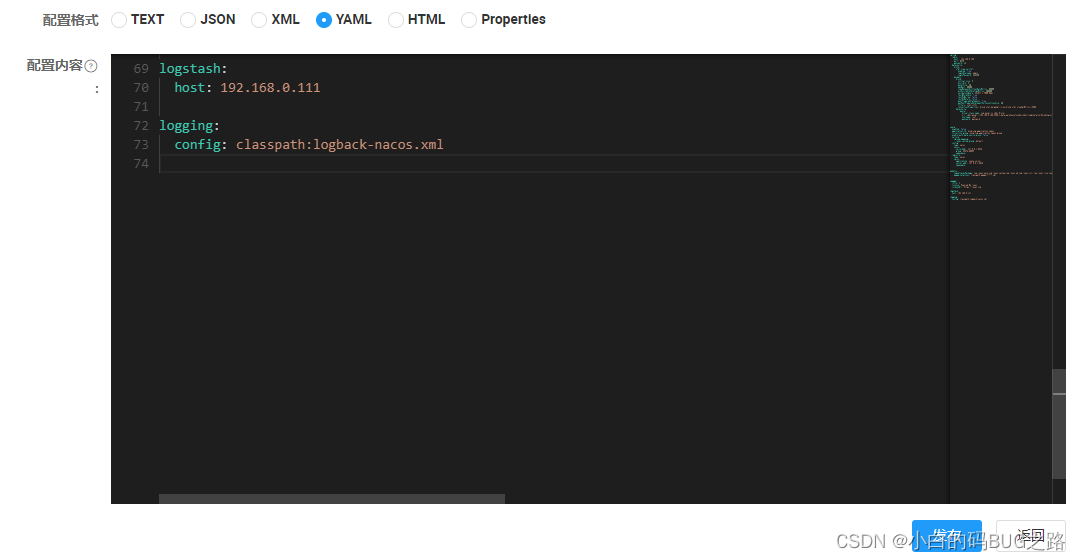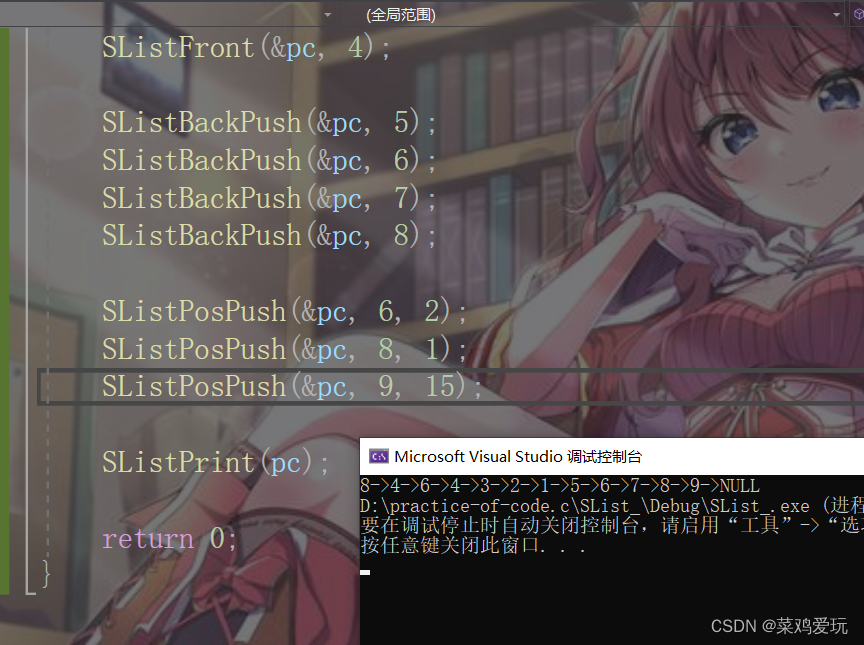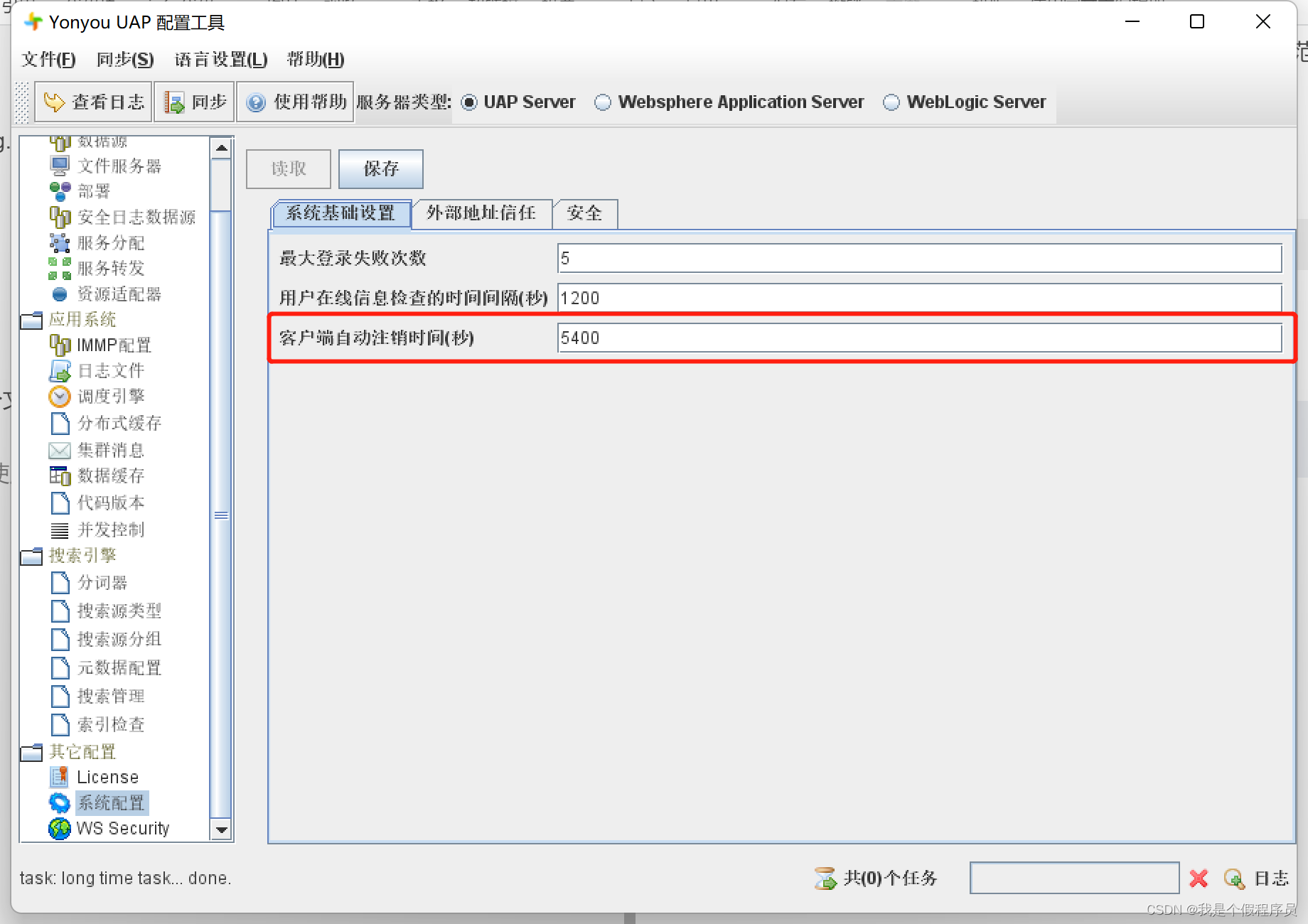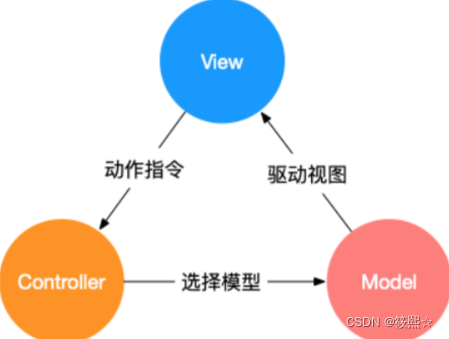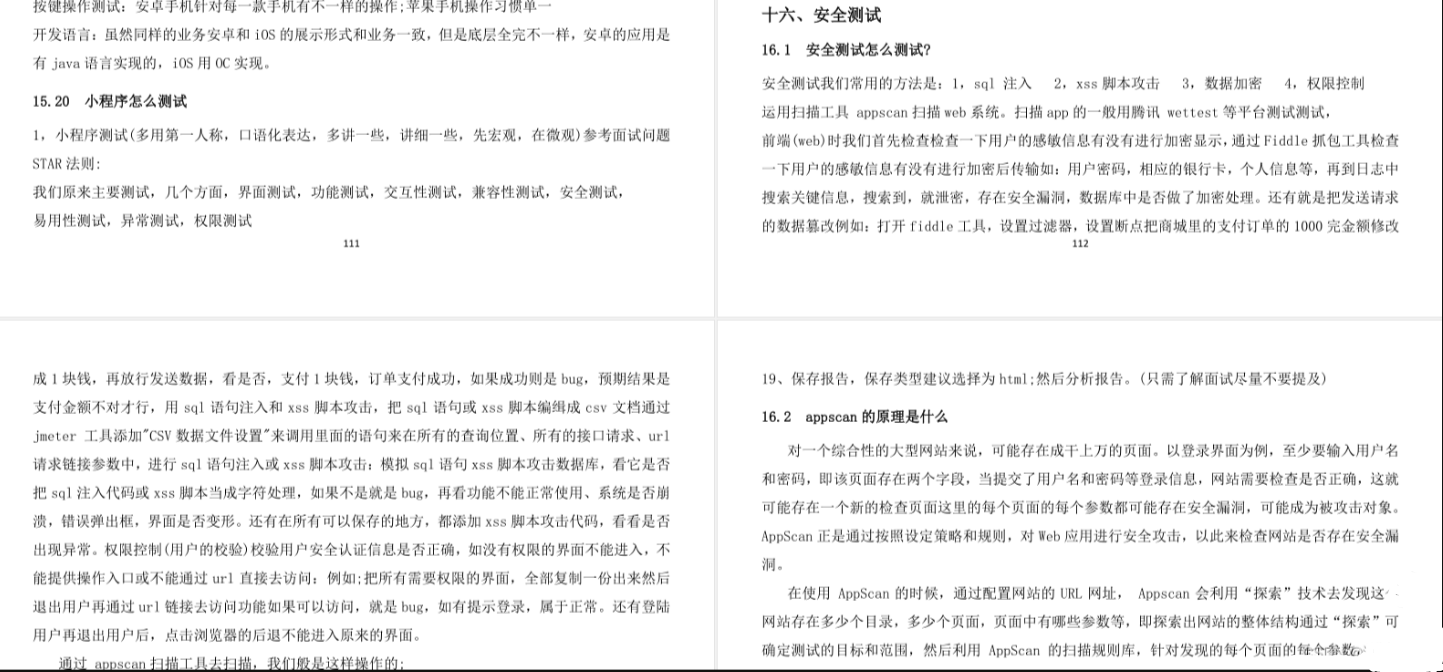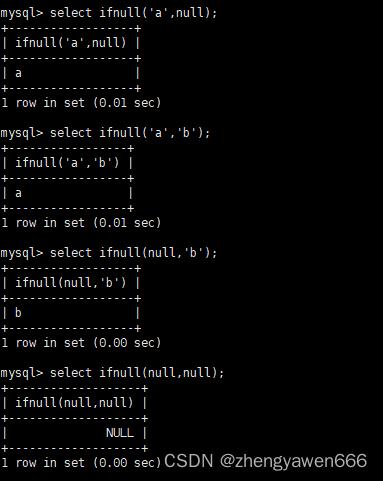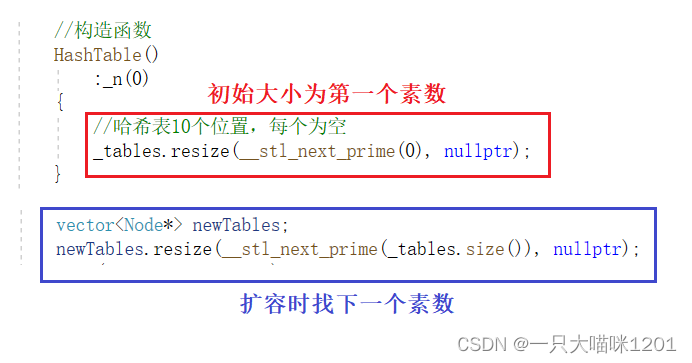文章目录
- 开散列哈希桶的模拟实现
- 哈希桶的基本框架
- 增加仿函数将数据类型转换为整型
- 哈希桶的插入函数
- 哈希桶的删除函数
- 哈希桶的查找函数
- 哈希桶的析构函数
- 建议哈希表的大小为素数
- 开散列与闭散列比较
- 哈希桶的时间复杂度及其测试
- 开散列哈希桶的模拟实现完整代码
开散列哈希桶的模拟实现
哈希桶的基本框架
由于哈希桶的本质就是一个存有结点指针的数组.所以哈希桶存储的数据类型便是结点指针类型.
哈希结点中包括两个内置成员:
1:K,V模型组成键值对pair<K,V>.(也可以是K模型)
2: 指向下一个结点的指针.
template <class K, class V>
struct HashNode //哈希结点
{
pair<K, V> _kv;
HashNode<K, V>* _next;
HashNode(const pair<K, V>& kv)
:_kv(kv)
, _next(nullptr)
{}
};
哈希桶的本质是一个指针数组.
其内置成员有两个:
1: 装有结点指针的vector.
2: 记录哈希桶的有效数据个数_size.
template < class K, class V>
struct HashTable
{
public:
//...
private:
vector<Node*> _table; //哈希桶.
size_t _size = 0; //记录哈希桶有效数据个数.
}
增加仿函数将数据类型转换为整型
此处仿函数与闭散列的仿函数一致并且接下来的插入,查找,删除等函数都调用仿函数,以下为仿函数代码:
template < class K >
struct HashFunc
{
size_t operator()(const K& key)
{
return (size_t)key;
}
};
template< > //仿函数的默认值,如果不显示传就会默认调用.
struct HashFunc <string>
{
size_t operator()(const string& key)
{
size_t val = 0;
for ( auto& ch : key ) //遍历string,将一个个字母替换成ASCI码进行相加.
{
val *= 131;
val += ch;
}
return val;
}
};
template < class K, class V,class Hash = HashFunc<K>> //模板参数增加一个仿函数.
struct HashTable
{
public:
//...
private:
vector<Node*> _table; //哈希桶.
size_t _size = 0; //记录哈希桶有效数据个数.
}
哈希桶的插入函数
哈希桶的插入主要分为3个步骤:
1: 去重.
2: 扩容
3: 插入.
以下就这3个步骤展开详谈:
1: 去重
(1)调用find函数,如果找到了,就说明哈希表中已经有了该数据,不需要插入,返回false.
(2)如果没找到,就将该数据插入.
2: 扩容
(1):计算新表的长度,创建新表.
(2): 遍历旧表,将旧表的数据按照头插的方式插入到哈希桶中.
(3): 调用vector中的swap函数,新表与旧表交换.
3: 插入
(1): 通过哈希函数计算映射位置.
(2) 将旧表数据头插移入到新表中.
(3) 更新_size.
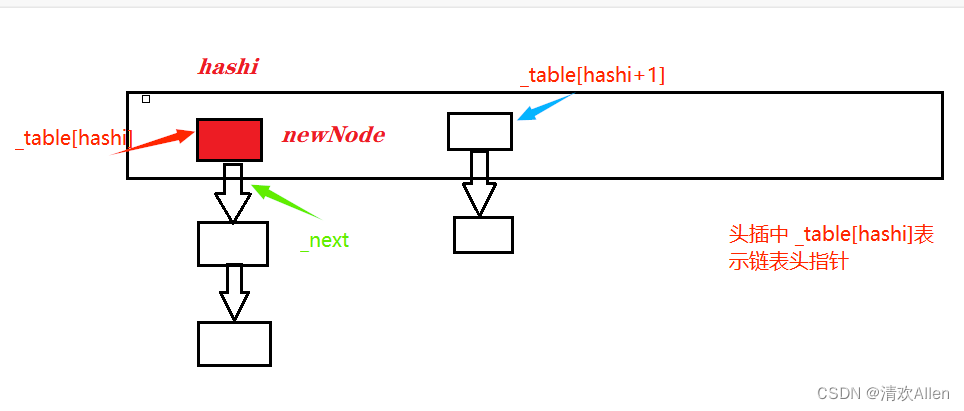
以下为插入函数完整代码:
bool Insert( const pair<K, V>& kv )
{
if (Find(kv.first)) //去重
{
return false;
}
//方法一: 调用Insert函数
//HashTable<K, V> newHT;
//newHT._table.resize(_table.size());
//for (auto cur : _table)
//{
// while (cur)
// {
// newHT.Insert(cur->_kv);
// cur = cur->_next;
// }
//}
// _table.swap(newHT._table);
//方法二: //直接将旧表数据移入到旧表中.
if (_size == _table.size()) //扩容.
{
// size_t newSize = _table.size() == 0 ? 10 : 2 * _table.size();
vector<Node*> newTable;
newTable.resize(GetNextPrime(_table.size()), nullptr); //扩容
Hash hash;
//从旧表结点移动映射新表.
for (size_t i = 0; i < _table.size(); ++i)
{
Node* cur = _table[i];
while (cur)
{
Node* next = cur->_next;
size_t hashi = hash( cur->_kv.first) % newTable.size();
cur->_next = newTable[hashi];
newTable[hashi] = cur;
cur = next;
}
_table[i] = nullptr;
}
_table.swap(newTable);
}
Hash hash1;
size_t hashi = hash1(kv.first) % _table.size();
Node* newNode = new Node(kv);
newNode->_next = _table[hashi];
_table[hashi] = newNode;
++_size;
return true;
}
注意:
方法一调用了Insert函数这样虽然可以解决创建新的哈希表导致每个数据的位置打乱,导致要重新计算插入位置的问题.可是,通过insert复用的办法,是生成了新的结点插入,函数栈帧结束后,旧表的数据结点通过调用析构函数销毁,可是,这样就会造成老的结点没有被充分运用的问题.
哈希桶的删除函数
能不能传pair键值对,调用find找到该结点进行删除呢?
不能,因为我们所设计的哈希桶为单链表(节省内存),find只能找到目标结点的位置,不能找到前一个结点的位置.因此,删除后删除结点的前后结点不能顺利连接.
删除函数主要分为3个步骤:
(1): 通过哈希函数确定删除目标结点哈希桶位置.
(2): 对哈希桶进行遍历,寻找删除目标结点.
(3)如果找到就删除该结点,如果没找到,就保留当前结点的位置,查找下一个结点.

bool Erase(const K& key)
{
if (_table.size() == 0)
{
return true;
}
Hash hash;
size_t hashi = hash(key) % _table.size();
Node* prev = nullptr;
Node* cur = _table[hashi];
while (cur) //找到哈希桶的位置,开始寻找目标结点.
{
if (cur->_kv.first == key)
{
if (prev == nullptr)
{
_table[hashi] = cur->_next;
}
else
{
prev->_next = cur->_next;
}
delete cur;
--_size;
return true;
}
prev = cur; //没找到就保存这个结点
cur = cur->_next;
}
return false;
}
哈希桶的查找函数
哈希桶的查找步骤如下:
(1): 如果表为空,表明找不到了,返回空.
(2): 通过哈希函数计算目标结点哈希桶的位置.
(3): 遍历哈希桶,如果找到,返回当前结点指针,没找到返回空.
Node* Find(const K& key)
{
if (_table.size() == 0) //表为空,就返回nullptr.
{
return nullptr;
}
Hash hash;
size_t hashi = hash(key) % _table.size();
Node* cur = _table[hashi];
while (cur)
{
if ( cur->_kv.first == key )
{
return cur;
}
cur = cur->_next;
}
return nullptr;
}
哈希桶的析构函数
当函数栈帧结束时,由于哈希表会调用它自己的析构函数,所以我们就不用对它额外显示写了.
但是,哈希桶中的结点没有析构函数无法析构,此时则需要我们额外对哈希桶显示写析构函数.
析构函数步骤如下:
(1): 遍历哈希表,找到每个哈希桶的头指针依次对哈希桶进行遍历删除(在删除时要提前保留下一个节点地址),直到整个表中的哈希桶全部删除.
(2) 删除完一个哈希桶就将该哈希桶的头指针设为nullptr.
~HashTable() //vvector会调用析构函数,但是哈希桶必须自己写.
{
for (size_t i = 0; i < _table.size(); ++i)
{
Node* cur = _table[i];
while (cur)
{
Node* next = cur->_next;
delete cur;
cur = next;
}
_table[i] = nullptr;
}
// cout << "~HushTable()" << endl;
}
建议哈希表的大小为素数
根据实验显示,使用除留余数法时,哈希表的大小最好是素数,这样能够降低哈希冲突概率. 可是怎么才能快速取一个类似两倍关系的素数?
STL中特意创建了一个素数数组,当插入函数需要扩容时,则遍历素数数组找到第一个大于哈希表中的数据个数的素数,这个素数就为新表的大小.
size_t GetNextPrime(size_t prime)
{
const int PRIMECOUNT = 28;
//素数序列
const size_t primeList[PRIMECOUNT] =
{
53, 97, 193, 389, 769,
1543, 3079, 6151, 12289, 24593,
49157, 98317, 196613, 393241, 786433,
1572869, 3145739, 6291469, 12582917, 25165843,
50331653, 100663319, 201326611, 402653189, 805306457,
1610612741, 3221225473, 4294967291
};
size_t i = 0;
for (i = 0; i < PRIMECOUNT; i++)
{
if (primeList[i] > prime) //从这个数组里面取第一个大于prime的值.
return primeList[i];
}
return primeList[i]; //虽然数据不可能那么大,但是也有可能不会走if判断,
// 所以从语法上来说还要考虑所给值prime大于素数数组整个数据的情况.
}
注意:
一般来讲,因为内存限制,我们不太可能需要一个最大素数大小的哈希表,但是有可能我们传的值会比最大素数还大.但是,从语法上考虑,当这种情况发生,我们应该也要返回一个值,这里返回素数数组中最大素数.
开散列与闭散列比较
应用链地址法(开散列)处理溢出,需要增设链接指针,似乎增加了存储开销。事实上: 由于闭散列必须保持大量的空闲空间以确保搜索效率,如二次探查法要求装载因子a <= 0.7,而表项所占空间又比指针大的多(闭散列存储数据类型为pair键值对与状态构成的对象所以比指针大的多),所以使用链地址法(开散列)反而比闭散列节省存储空间
哈希桶的时间复杂度及其测试
我们知道,在最坏情况下,所给的数据都发生哈希冲突,此时的时间复杂度为O(N),但是这种情况出现的概率极低,那么哈希桶的时间复杂度是多少呢?
哈希桶随机数测试:
但测试数据为100000个时,此时负载因子为0.677594,其中在62681个桶中最长的桶的长度才为2,平均每个桶的长度才为1.06283.
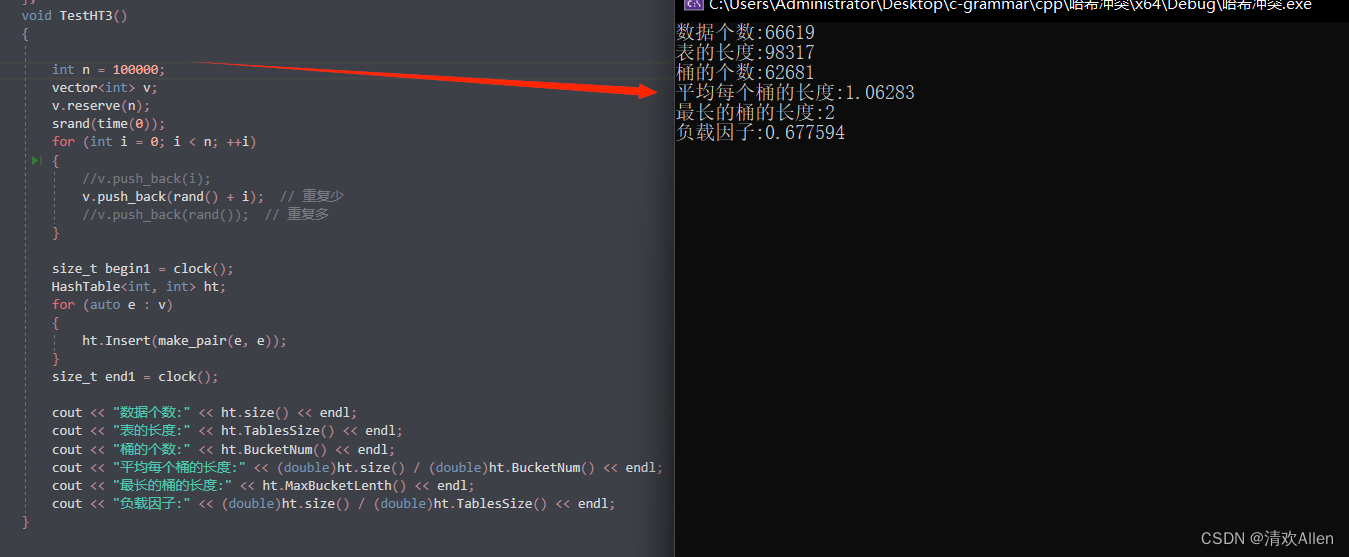
当测试数据为200000个时,此时负载因子为0.660307可见和上次相比这次测试已经扩了容,但是最长的桶的长度也仅为2,平均桶的长度为1.03515.
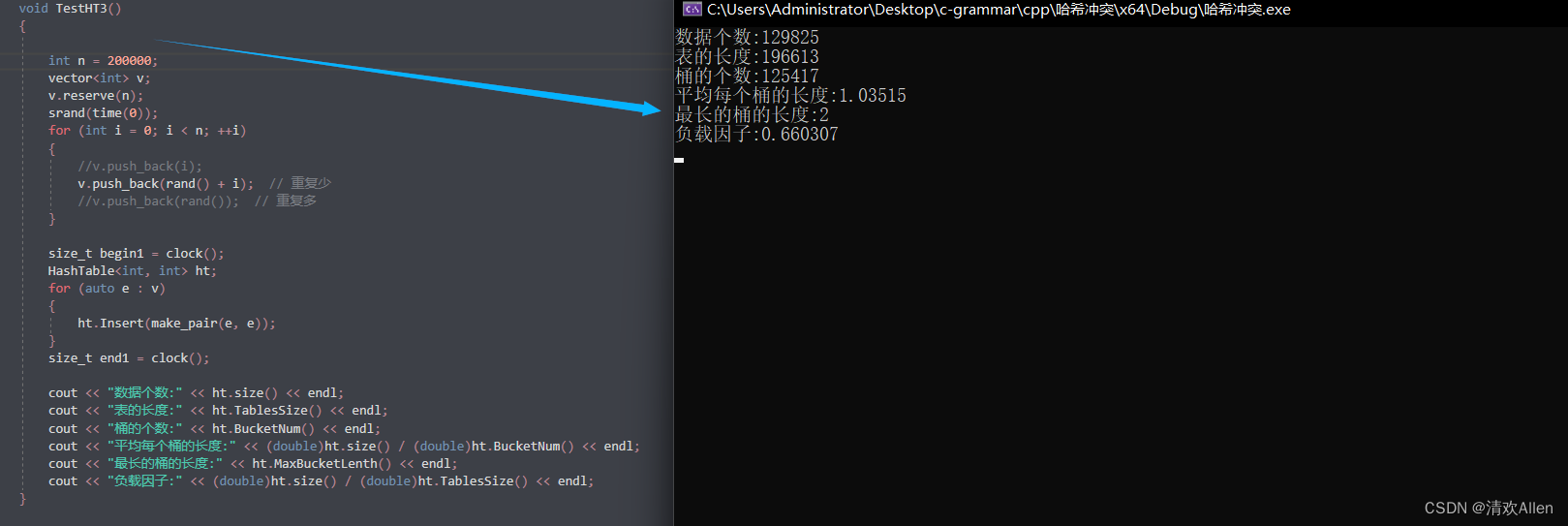
综合以上情况: 在平均情况下,哈希表中每个位置的哈希桶的数据个数大概为常数个,所以时间复杂度一般为O(1).
开散列哈希桶的模拟实现完整代码
#include <map>
#include <vector>
#include <string>
#include <iostream>
using namespace std;
namespace HashBucket
{
template < class K > //仿函数的默认值,如果不显示传就会默认调用.
struct HashFunc
{
size_t operator()(const K& key)
{
return (size_t)key;
}
};
template< > //1:对于常见类型,为了方便,我们可以对类模板进行特化.
struct HashFunc <string> //并且根据实参所传类型,优先走特化版本.
{
size_t operator()(const string& key)
{
size_t val = 0;
for (auto& ch : key) //遍历string,将一个个字母替换成ASCI码进行相加.
{
val += ch;
}
return val;
}
};
template <class K, class V>
struct HashNode
{
pair<K, V> _kv;
HashNode<K, V>* _next;
HashNode(const pair<K, V>& kv)
:_kv(kv)
, _next(nullptr)
{}
};
template < class K, class V, class Hash = HashFunc<K> >
struct HashTable
{
typedef HashNode<K, V> Node;
public:
size_t GetNextPrime(size_t prime)
{
const int PRIMECOUNT = 28;
//素数序列
const size_t primeList[PRIMECOUNT] =
{
53, 97, 193, 389, 769,
1543, 3079, 6151, 12289, 24593,
49157, 98317, 196613, 393241, 786433,
1572869, 3145739, 6291469, 12582917, 25165843,
50331653, 100663319, 201326611, 402653189, 805306457,
1610612741, 3221225473, 4294967291
};
size_t i = 0;
for (i = 0; i < PRIMECOUNT; i++)
{
if (primeList[i] > prime) //从这个数组里面取第一个大于prime的值.
return primeList[i];
}
return primeList[i]; //虽然数据不可能那么大,但是也有可能不会走if判断,
// 所以从语法上来说还要考虑所给值prime大于素数数组整个数据的情况.
}
~HashTable() //vvector会调用析构函数,但是哈希桶必须自己写.
{
for (size_t i = 0; i < _table.size(); ++i)
{
Node* cur = _table[i];
while (cur)
{
Node* next = cur->_next;
delete cur;
cur = next;
}
_table[i] = nullptr;
}
// cout << "~HushTable()" << endl;
}
bool Erase(const K& key)
{
if (_table.size() == 0)
{
return true;
}
Hash hash;
size_t hashi = hash(key) % _table.size();
Node* prev = nullptr;
Node* cur = _table[hashi];
while (cur)
{
if (cur->_kv.first == key)
{
if (prev == nullptr)
{
_table[hashi] = cur->_next;
}
else
{
prev->_next = cur->_next;
}
delete cur;
--_size;
return true;
}
prev = cur;
cur = cur->_next;
}
return false;
}
bool Insert(const pair<K, V>& kv)
{
if (Find(kv.first)) //去重
{
return false;
}
if (_size == _table.size()) //扩容.
{
// size_t newSize = _table.size() == 0 ? 10 : 2 * _table.size();
vector<Node*> newTable;
newTable.resize(GetNextPrime(_table.size()), nullptr); //扩容
Hash hash;
//从旧表结点移动映射新表.
for (size_t i = 0; i < _table.size(); ++i)
{
Node* cur = _table[i];
while (cur)
{
Node* next = cur->_next;
size_t hashi = hash( cur->_kv.first) % newTable.size();
cur->_next = newTable[hashi];
newTable[hashi] = cur;
cur = next;
}
_table[i] = nullptr;
}
_table.swap(newTable);
}
Hash hash1;
size_t hashi = hash1(kv.first) % _table.size();
Node* newNode = new Node(kv);
newNode->_next = _table[hashi];
_table[hashi] = newNode;
++_size;
return true;
}
Node* Find(const K& key)
{
if (_table.size() == 0) //表为空,就返回nullptr.
{
return nullptr;
}
Hash hash;
size_t hashi = hash(key) % _table.size();
Node* cur = _table[hashi];
while (cur)
{
if ( cur->_kv.first == key )
{
return cur;
}
cur = cur->_next;
}
return nullptr;
}
size_t size() //哈希表的数据个数
{
return _size;
}
size_t TablesSize() //表的长度
{
return _table.size();
}
size_t BucketNum() //有多少个桶被用了.
{
size_t Num = 0;
for (size_t i = 0; i < _table.size(); ++i)
{
if (_table[i])
{
++Num;
}
}
return Num;
}
size_t MaxBucketLenth() //哈希桶的最大桶长
{
size_t maxLen = 0;
for (size_t i = 0; i < _table.size(); ++i)
{
size_t len = 0;
Node* cur = _table[i];
while (cur)
{
++len;
cur = cur->_next;
}
if ( len > maxLen )
{
maxLen = len;
}
}
return maxLen;
}
private:
vector<Node*> _table;
size_t _size = 0;
};
void TestHT3() //哈希桶时间复杂度测试.
{
int n = 200000;
vector<int> v;
v.reserve(n);
srand(time(0));
for (int i = 0; i < n; ++i)
{
//v.push_back(i);
v.push_back(rand() + i); // 重复少
//v.push_back(rand()); // 重复多
}
size_t begin1 = clock();
HashTable<int, int> ht;
for (auto e : v)
{
ht.Insert(make_pair(e, e));
}
size_t end1 = clock();
cout << "数据个数:" << ht.size() << endl;
cout << "表的长度:" << ht.TablesSize() << endl;
cout << "桶的个数:" << ht.BucketNum() << endl;
cout << "平均每个桶的长度:" << (double)ht.size() / (double)ht.BucketNum() << endl;
cout << "最长的桶的长度:" << ht.MaxBucketLenth() << endl;
cout << "负载因子:" << (double)ht.size() / (double)ht.TablesSize() << endl;
}
}
